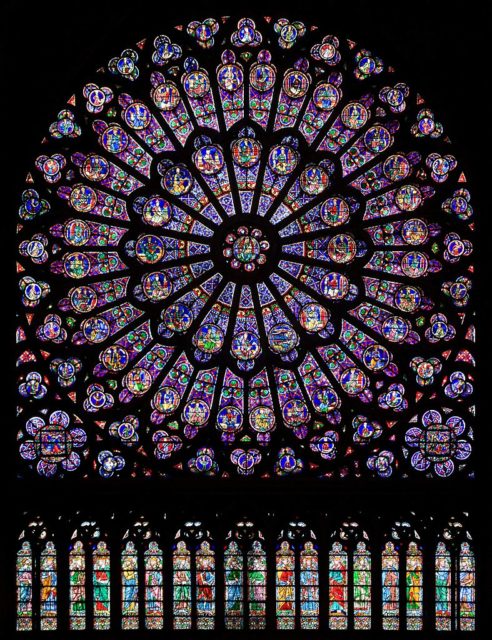Mark Steyn, who is not normally noted for his habit of bringing good news, actually has some good news to share as the authorities in Paris evaluate the damage to the cathedral after the fire of April 15th:

The north rose window of the Cathédrale Notre-Dame de Paris, in a photo from 22 August, 2010. This and the other two rose windows are reported to have survived the fire of 15 April, 2019.
Photo by Julie Anne Workman. License: CC-BY-SA 3.0 via Wikimedia Commons.
Twenty-four hours after Notre Dame de Paris began to burn, there is better news than we might have expected: More of the cathedral than appeared likely to has, in fact, survived intact – including the famous rose windows, among the most beautiful human creations I’ve ever seen. The “new” Notre Dame will be mostly high up and out of sight, which is just as well given that modern man prides himself on having no smidgeonette of empathy with his flawed forebears and thus the chances of historic recreation of the animating spirit of 1160 are near zero.
There is an architectural debate to be had, I suppose, about whether a reconstructed twelfth-century cathedral requires nineteeth-century appurtenances such as its spire. But the minute that starts you risk some insecure dweeb like Macron, on whose watch the thing went up in smoke, getting fanciful ideas about bequeathing to posterity some I M Pei pyramid on the top of the roof. France’s revolution, unlike America’s, was aggressively secular, and it ultimately found expression in the 1905 law on the separation of churches and the state. Since then the French state has owned the cathedral, and thus it will be Macron who ultimately decides what arises in its place.
Beyond that are the larger questions: When the iconic house of worship at the heart of French Christianity decides to mark Holy Week by going up in flames, it’s too obviously symbolic of something … but of what exactly? Two thousand churches have been vandalized in the last two years: Valérie Boyer, who represents Bouches-du-Rhône in the National Assembly, said earlier this month that “every day at least two churches are profaned” – by which she means arson, smashed statutes of Jesus and Mary, and protestors who leave human fecal matter in the shape of a cross. This is a fact of life in modern France.
As it is, there is no shortage of excitable young Mohammedans gleefully celebrating on social media. In 2017 some inept hammer-wielding nutter yelling “Allahu Akbar!” had a crack at Notre Dame, and a couple of years before that the historian Dominique Venner blew his brains out on the altar to protest same-sex marriage. I love France but, in recent years, it’s hard not to pick up on the sense that it’s coming apart – and that, when the center cannot hold, the things at that center, the obsolete embodiments of a once cohesive society, are a natural target.
In addition, the authorities’ eagerness to assure us that it was an accident at a time when such a conclusion could not possibly be known – and when their own response to the emergency was, to put it politely, somewhat dilatory – was itself enough to invite suspicion: “Sure, it might be an accident. But, even if it weren’t, they’d still tell us it was…”
So, precisely because Paris is full of people who would love to burn down Notre Dame four days before Good Friday, it seems bizarrely improbable that it should happen by accident: that a highly desirable target should be taken out by some slapdash workman leaving a cigarette butt near his combustible foam take-out box – the lunchpack of Notre Dame – and letting the dried-out twelfth-century timbers do the rest.
The Rose Window was spared! pic.twitter.com/D5NjepKzh3
— The French History Podcast (@FrenchHist) April 16, 2019



